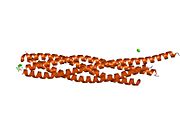
SNARE proteins – "SNAPREceptors" – are a large protein family consisting of at least 24 members in yeasts, more than 60 members in mammalian cells, and some numbers in plants. The primary role of SNARE proteins is to mediate the fusion of vesicles with the target membrane; this notably mediates exocytosis, but can also mediate the fusion of vesicles with membrane-bound compartments. The best studied SNAREs are those that mediate the release of synaptic vesicles containing neurotransmitters in neurons. These neuronal SNAREs are the targets of the neurotoxins responsible for botulism and tetanus produced by certain bacteria.

Synaptosomal-Associated Protein, 25kDa (SNAP-25) is a Target Soluble NSF (N-ethylmaleimide-sensitive factor) Attachment Protein Receptor (t-SNARE) protein encoded by the SNAP25 gene found on chromosome 20p12.2 in humans. SNAP-25 is a component of the trans-SNARE complex, which accounts for membrane fusion specificity and directly executes fusion by forming a tight complex that brings the synaptic vesicle and plasma membranes together.

Syntaxin-1A is a protein that in humans is encoded by the STX1A gene.

Synaptosomal-associated protein 23 is a protein that in humans is encoded by the SNAP23 gene. Two alternative transcript variants encoding different protein isoforms have been described for this gene.

Syntaxin-4 is a protein that in humans is encoded by the STX4 gene.

Vesicle-associated membrane protein 2 (VAMP2) is a protein that in humans is encoded by the VAMP2 gene.

Syntaxin-binding protein 1 is a protein that in humans is encoded by the STXBP1 gene. This gene encodes a syntaxin-binding protein. The encoded protein appears to play a role in release of neurotransmitters via regulation of syntaxin, a transmembrane attachment protein receptor. Mutations in this gene have been associated with neurological disorders including epilepsy, intellectual disability, and movement disorders.

Vesicle-associated membrane protein 7 (VAMP-7), is a protein that in humans is encoded by the VAMP7 gene also known as the or SYBL1 gene.

Syntaxin-7 is a protein that in humans is encoded by the STX7 gene.

Syntaxin-6 is a protein that in humans is encoded by the STX6 gene.

Vesicle-associated membrane protein 3 is a protein that in humans is encoded by the VAMP3 gene.

Vesicle-associated membrane protein-associated protein B/C is a protein that in humans is encoded by the VAPB gene. The VAPB gene is found on the 20th human chromosome. Together with VAPA, it forms the VAP protein family.

Syntaxin-5 is a protein that in humans is encoded by the STX5 gene.

Syntaxin-2, also known as epimorphin, is a protein that in humans is encoded by the STX2 gene.

Vesicle-associated membrane protein 8 is a protein that in humans is encoded by the VAMP8 gene.

Vesicle-associated membrane protein 4 is a protein that in humans is encoded by the VAMP4 gene.

Syntaxin-binding protein 5 is a protein that in humans is encoded by the STXBP5 gene. It is also known as tomosyn, after 友, "friend" in Japanese, for its role as a binding protein.
Vesicle-associated membrane protein 5 (VAMP-5) is a synaptobrevin protein encoded in the human by the VAMP5 gene.

Syntaxin 3, also known as STX3, is a protein which in humans is encoded by the STX3 gene.

Syntaxins are a family of membrane integrated Q-SNARE proteins participating in exocytosis.

























